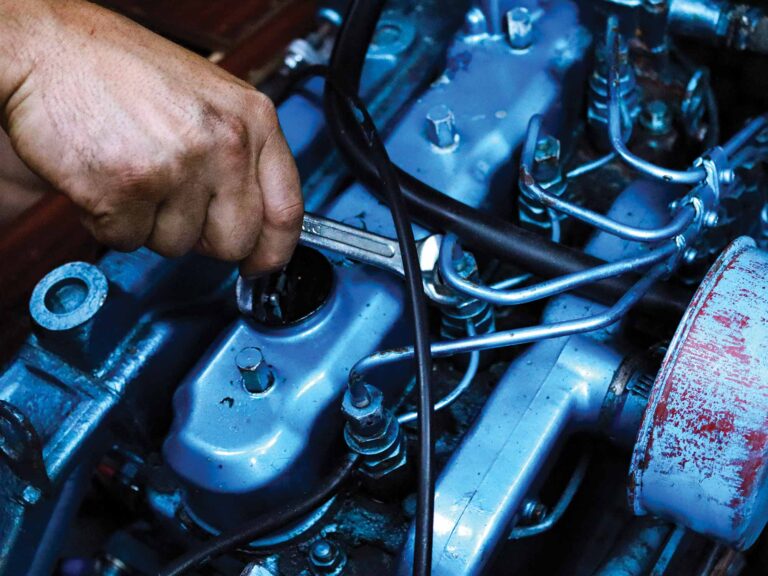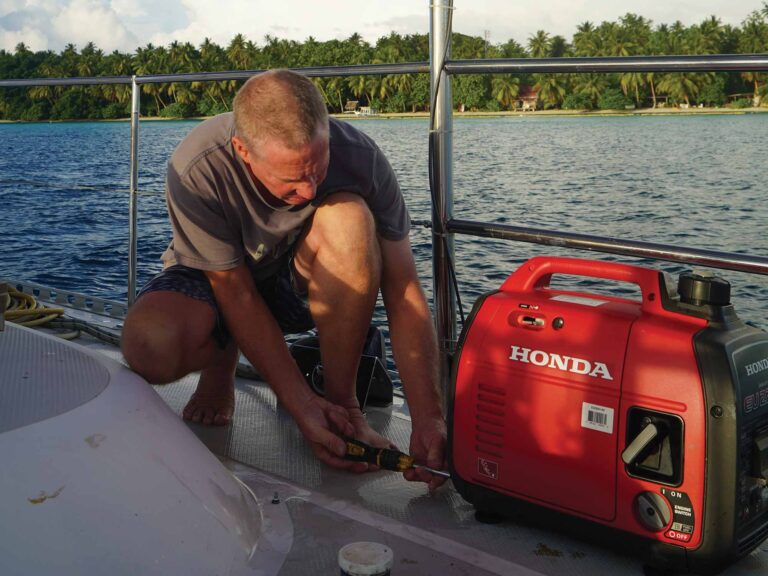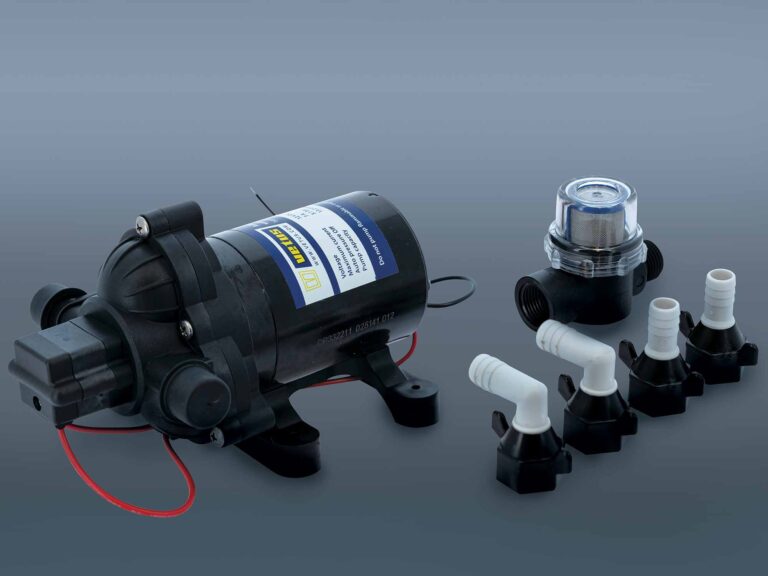Bob Piccoli took a well-trodden road to acquiring Big Dog II, a Lagoon 400 S2 he bought and placed in the Dream Yacht Charter fleet on Great Abaco Island, Bahamas, a year ago. His journey was filled with research and Web surfing, visits to boat shows, chats with brokers, and tête-à-têtes with his wife, Cheryl, who was new to sailing.
“I spent five years mulling it over,” Bob says. “I looked at all the different financing programs and charter companies. I went to the U.S. Sailboat Show in Annapolis, Maryland, every year. Boat shows are great because you can sit on the boats and the salespeople are there to answer all your questions.”
Slowly but surely, Bob and Cheryl figured out what they wanted, as well as what they didn’t want. “At first,” Bob says, “I had my heart set on a big monohull. My wife looked at those and basically said, ‘No way.’ Then we saw a Lagoon cat, and she said, ‘That’ll work.’ She also had to be able to handle the boat herself in an emergency if she had to, and she can now.
“As for me, I didn’t want a cookie-cutter boat,” he says. “I wanted a boat fitted out my way. If I wanted a helm with all power winches, I could have it. If I wanted satellite TV, I could have it. If I wanted four staterooms, done. I got to choose the interior colors. Spinnaker, genny — what I wanted, I could have.
“I wanted my own private locker for my scuba and snorkeling gear so I don’t have to carry it back and forth. If I buy cans of tuna fish, sugar, salt, I can store them without having to reprovision every time I come to the boat. [A private locker onboard was included in the agreement.] It’s also important to me to know my boat’s being maintained properly.
“I can take it out on charter up to 12 times a year, and use it when it’s not in charter. In my case I want the boat to pay for itself and build equity for the final boat I plan to retire upon. I can do what I want with it.”
Sounds ideal, right? For sailors eager to attain Bob Piccoli’s level of satisfaction, he shares a few tips:
- Understand that this is a major financial investment.
“If they tell you it’s going to pay for itself in the first year, don’t walk away, run,” Bob says. Be certain you can handle miscellaneous startup costs.
- Ask yourself what you ultimately want from this boat.
“Do you want it to pay for itself and then sail away on it? Are you going to trade it in? You have to know what you want to do with the boat,” Bob says.
- Be comfortable with the charter company you’re dealing with.
“They’re managing and maintaining your boat,” Bob says. “They’re doing all the things that are required. They’re not always going to call you. You have to be comfortable with that.”
Questions — and Answers
Those insights about the boat, the company and the related costs only skim the surface of a type of ownership arrangement that’s not as basic as renting and that can turn out to be a far more emotional investment than a time share. Eager to learn more basic details about charter yacht management and the variety of programs, destinations and financing options available, I sent a set of questions to a number of companies as well as to Bob.
Those who participated included global outfits, such as The Moorings and Dream Yacht Charter; midsize companies like Catamaran Company and Horizon Yacht Charters; boutique-style operations like CYOA Yacht Charters; and domestic operators such as Bavaria USA and Great Lakes Sailing Company.
Their feedback shows that just about any arrangement is possible, and the key, as Bob points out, is to know what you want going into the deal. The questions and composite answers below, followed by Bob’s answers, can help vacation sailors pin down the right match.
Q: When you buy a boat and put it into a charter fleet, is it to broaden vacation sailing options, to cover the expense of sailing vacations or to make money? Tell us in basic terms what the financial risks and rewards are, and how much it really costs.
A: Buying a boat and placing it in a charter fleet is fundamentally about financing the cost of sailing vacations, and in many cases, paying down the mortgage on the hull. It’s not a way to make money, but the best-run programs guarantee that at the end of the term, whether one year, three years, five years or longer, owners who use their boats in one cruising ground or use sister ships offered at other destinations will have done so without losing money.
Some companies pay all expenses and give the owner a guaranteed payment that will cover a portion or all of the mortgage; others professionally manage boats owned outright, arranging for charters to help defray and sometimes completely offset all expenses.
Bob: It’s a little of all three. We enjoy sailing in the Bahamas, where our boat is based. Chartering it out helps pay for the boat and expenses, and we can also charter boats in other Dream Yacht Charter locations, so we get the best of all worlds. In my case, it is my boat and the mortgage is in my name, so if the boat doesn’t break even on any given month (there are slow months) I’m writing a check. That is a big financial risk you must be ready to take on. There are also other costs up front.
The first year, you should be prepared to pay the mortgage note every month. In my case, the charter company has covered about half the payments after expenses. Next year should be a bit better, and there will not be as many initial costs.
The reward? Eventually it will be my boat, and I am not shelling out charter fees to another company when I sail with no return. Let’s face it, sailing is an expensive hobby. If you break even in any given year you did great.
Q: What kind of reciprocity do you get when you place a boat in charter? How many weeks do you get to sail your boat? What does it cost you, the owner, and where do you get to sail?
A: The actual time varies, but an owner usually gets from 2 to 12 weeks. Large companies offer owners time aboard sister ships at various worldwide bases. Owners are charged for items such as cleaning, linens, ice, gas and dinghy use; costs can run to several hundred dollars.
Bob: With my agreement, I get up to 12 weeks per year on our boat or on another boat in the Dream Yacht Charter fleet anywhere in the world. The beauty is that it is my boat, so costs are simply food and fuel. I can log on to the company website and see if it is being used any week. If not, we can take advantage of the down time and use the boat. There are other tax advantages that reduce that cost further, but that is based on each individual’s position.
Q: How do you ensure the boat is well maintained? Is it checked before and after each charter? What maintenance expense is covered by the company, and what is left to the owner to bear?
A: Maintenance is done and recorded regularly, yet how it’s paid for varies among companies. Some companies pay all maintenance and examine the boat before and after each charter, periodically and annually. Others examine the boat after each charter so the boat runs smoothly for the next one. Inspection can involve a mechanic, rigger, shipwright, diver and underwater video footage. Some companies allow the owners to perform annual maintenance. Some companies split maintenance costs with owners; others hammer out customized agreements with owners specifying who pays exactly what.
Bob: My boat is almost a year old and has had 18 charters. We just returned from a trip to the boat. While I have to say there was some expected wear, the boat really looked almost new. Costs are split based on the contract and program I have signed up for. This was something we researched before we picked a company. We looked at charter companies’ boats after they had been in charter for a year or so to see how they fared and were maintained; we checked what the splits were and who paid for what. This is a key factor, as we all know boats aren’t cheap to maintain.
Q: Explain the insurance, liability and warranty aspects of the charter yacht management arrangement. Are warranties available?
A: Charter companies have policies in place to cover the fleets and the owners. In some circumstances, charterers are charged for the deductible in the form of a damage or collision waiver, so the owner is spared the expense. Warranties on new boats are specified by the manufacturers.
Bob: The charter company handles all the paperwork for me, ensuring that the boat is insured. After each charter, the boat is inspected for damage and the company bills accordingly.
Q: When your ownership program is over, do you get the boat free and clear? Can you resell it? What if you don’t want the boat? Conversely, what if you already own a boat and want to charter it to offset some expenses? What are your options for management?
A: How much of the boat you own depends on the term of your mortgage and the success of the income program of the company you worked with. In many cases, the owner can make up most of the mortgage by selling the boat. Charter companies can assist with brokerage. Also, owners can trade in boats at the end of the term to continue the management relationship and allow for continued sailing opportunities. Large charter companies don’t accept pre-owned boats into their fleets, but various smaller companies do.
Bob: I own the boat, I pay the mortgage, so to speak. So I will ultimately own the boat to keep, trade, sell or sail.
Resources
Each company devotes a portion of its website to yacht ownership programs. The Moorings also has a separate site dedicated to charter, private and pre-owned yacht ownership program options.
Atlantic Cruising Yachts
Catamaran Company
CYOA Yacht Charters
Dream Yacht Charter
Horizon Yacht Charters
Sail Caribe
Sunsail
The Moorings
TMM Yacht Charters
There are many varied programs for charter sailboat ownership and management. To read about specific programs offered by each company, click here.

Cheryl and Bob Piccoli













